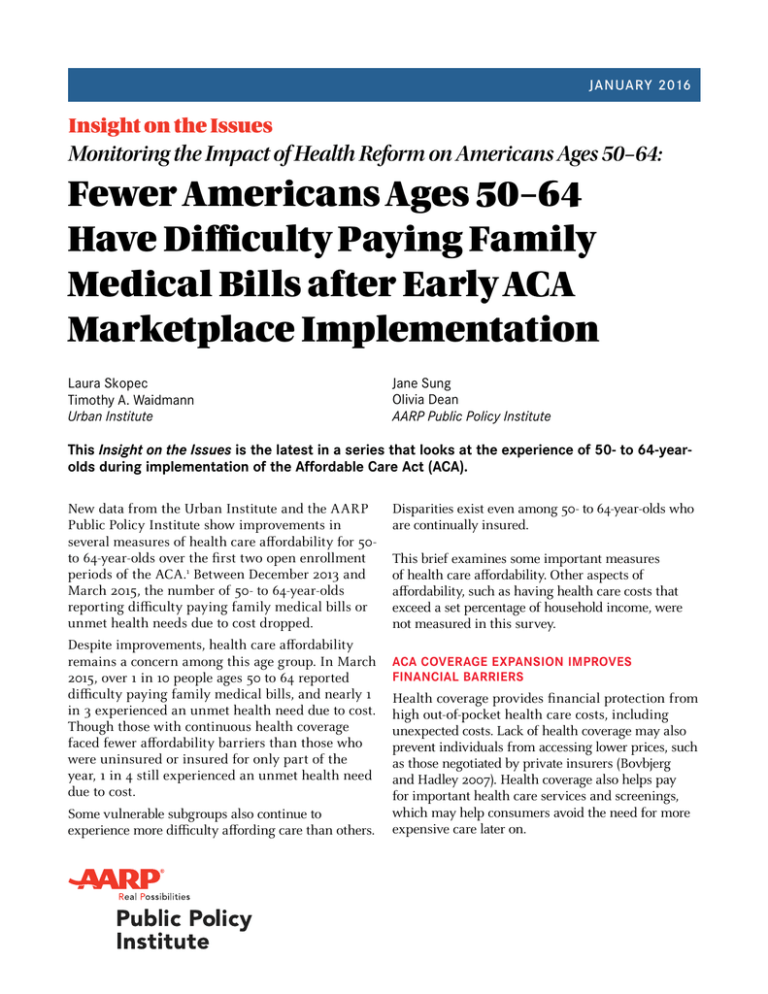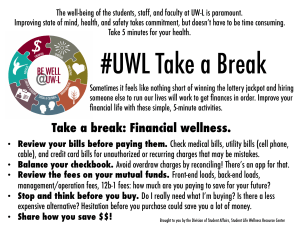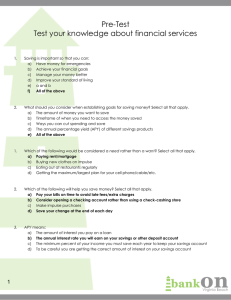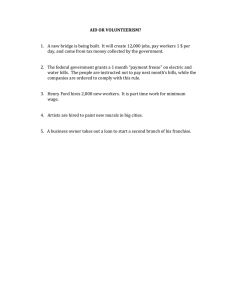Fewer Americans Ages 50–64 Have Difficulty Paying Family Marketplace Implementation
advertisement

JANUARY 2016 Insight on the Issues Monitoring the Impact of Health Reform on Americans Ages 50–64: Fewer Americans Ages 50–64 Have Difficulty Paying Family Medical Bills after Early ACA Marketplace Implementation Laura Skopec Timothy A. Waidmann Urban Institute Jane Sung Olivia Dean AARP Public Policy Institute This Insight on the Issues is the latest in a series that looks at the experience of 50- to 64-yearolds during implementation of the Affordable Care Act (ACA). New data from the Urban Institute and the AARP Public Policy Institute show improvements in several measures of health care affordability for 50to 64-year-olds over the first two open enrollment periods of the ACA.1 Between December 2013 and March 2015, the number of 50- to 64-year-olds reporting difficulty paying family medical bills or unmet health needs due to cost dropped. Despite improvements, health care affordability remains a concern among this age group. In March 2015, over 1 in 10 people ages 50 to 64 reported difficulty paying family medical bills, and nearly 1 in 3 experienced an unmet health need due to cost. Though those with continuous health coverage faced fewer affordability barriers than those who were uninsured or insured for only part of the year, 1 in 4 still experienced an unmet health need due to cost. Some vulnerable subgroups also continue to experience more difficulty affording care than others. Disparities exist even among 50- to 64-year-olds who are continually insured. This brief examines some important measures of health care affordability. Other aspects of affordability, such as having health care costs that exceed a set percentage of household income, were not measured in this survey. ACA COVERAGE EXPANSION IMPROVES FINANCIAL BARRIERS Health coverage provides financial protection from high out-of-pocket health care costs, including unexpected costs. Lack of health coverage may also prevent individuals from accessing lower prices, such as those negotiated by private insurers (Bovbjerg and Hadley 2007). Health coverage also helps pay for important health care services and screenings, which may help consumers avoid the need for more expensive care later on. JANUARY 2016 Health coverage for 50- to 64-year-olds improved significantly under the ACA: the uninsured rate dropped by nearly half between December 2013 and March 2015 (Skopec et al. 2015). Prior to the ACA, 50to 64-year-olds without access to employer-sponsored insurance had few options to obtain health coverage (Weiss, Waidmann, and Caswell 2014). FIGURE 1 Share of 50- to 64-Year-Olds with Difficulty Paying Family Medical Bills, in December 2013 and March 2015 19.6% The ACA addresses access to, quality of, and affordability of health coverage by: 15.0%** •• Creating health insurance marketplaces where individuals and small businesses can shop for insurance and easily compare prices and coverage options and enroll in coverage; •• Expanding Medicaid (for states that choose to do so) to people with incomes up to 138 percent of the federal poverty level (FPL); •• Providing subsidies for low- and moderate-income people (incomes up to 400 percent of FPL) who purchase coverage through the health insurance marketplaces. The subsidies help defray premiums and out-of-pocket costs; December 2013 March 2015 Source: HRMS-AARP Public Policy Survey, December 2013 and March 2015. •• Requiring insurers to cover preexisting conditions without limitations or waiting periods; Note: All affordability measures are over the past 12 months. Data are not adjusted for changes in the characteristics of the sample population over time. •• Limiting cost sharing, including deductibles, copays, and coinsurance in most insurance plans; * * Estimate is significantly different from estimate for December 2013 at the 0.05/0.01 level using two-tailed tests. •• Prohibiting annual or lifetime dollar limits on essential health benefits; and •• Requiring private nongroup and small group health insurance plans to cover essential health benefits2 including prescription drugs, hospitalizations, and preventive services. The share of 50- to 64-year-olds with difficulty paying medical bills dropped by a similar degree in both states that chose to expand Medicaid under the ACA and states that did not (figure 2). However, in March 2015, a larger share of 50- to 64-year-olds still reported difficulty paying medical bills in in nonexpansion states (17.9 percent) than did in expansion states (13.3 percent). RESULTS Fewer 50- to 64-Year-Olds Have Difficulty Paying Medical Bills In March 2015, 23.5 percent fewer 50- to 64-year-olds reported having difficulty paying family medical bills than in December 2013.3 This demonstrates an improvement in affordability, with 19.6 percent of 50- to 64-year-olds reporting difficulty paying family medical bills in December 2013, compared with 15 percent of 50- to 64-year-olds reporting the same in March 2015 (figure 1).4 Fewer 50- to 64-Year-Olds Have Unmet Needs for Care Due to Cost Between December 2013 and March 2015, the share of 50- to 64-year-olds with any unmet need for medical or dental care due to cost dropped modestly, from 31.6 percent to 30.1 percent (figure 3). 2 JANUARY 2016 FIGURE 2 Share of 50- to 64-Year-Olds with Difficulty Paying Family Medical Bills in December 2013 and March 2015, by State Medicaid Expansion Status 22.9% December 2013 17.9%** 17.6% March 2015 13.3%** Expansion states Nonexpansion states Source: HRMS-AARP Public Policy Survey, December 2013 and March 2015. Note: All affordability measures are over the past 12 months. Data are not adjusted for differences in demographic, socioeconomic, or health status between expansion and nonexpansion states. * * Estimate is significantly different from estimate for expansion states at the 0.01 level using two-tailed tests. A closer look shows that this drop appears to be driven by fewer individuals with an unmet need for tests or follow-up care, mental health care, and dental care in March 2015 than in December 2013 (figure 3). No significant changes occurred for unmet needs for doctor care or prescription drugs (data not shown). Improvements Occurred across Demographic Boundaries Between December 2013 and March 2015, the share of 50- to 64-yearolds with difficulty paying family medical bills dropped across all demographic groups included in this analysis (figure 4). Some subgroups experienced particularly large improvements: •• Individuals with family incomes at or below 138 percent of the FPL: The share of 50- to 64-year-olds with family incomes at or below 138 percent of the FPL who reported difficulty paying family medical bills over the past 12 months fell 33 percent, from 35.1 to 23.7 percent, between December 2013 and March 2015. The share reporting any unmet need for care also fell 14 percent, from 57.7 3 to 49.4 percent, over the same time period (data not shown). •• Racial and ethnic minorities: The share of 50- to 64-year-old non-Hispanic blacks reporting difficulty paying family medical bills over the past 12 months fell 32 percent, from 27.3 percent to 18.5 percent, between December 2013 and March 2015. During the same time period, the share of Hispanic 50- to 64-year olds with difficulty paying family medical bills fell 22 percent, from 23.0 percent to 18.0 percent, and the share of nonHispanic whites dropped 21 percent, from 18.0 percent to 14.3 percent. Higher Share of Uninsured and Part-Year Insured Report Difficulty Affording Care Despite overall improvements in affordability measures, a closer look at length of coverage shows that 50- to 64-year-olds with no insurance or insurance for only part of the year faced greater difficulty affording care than those who had continuous coverage (insurance all year) (figure 5). When surveyed in March 2015, more than half (57.7 percent) of 50- to 64-year-olds with insurance for only part of the previous 12 months had an unmet need for care due to cost, and 28.4 percent had difficulty paying family medical bills. In contrast, 50- to 64-year-olds with continuous coverage reported the least difficulty affording care. In March 2015, only 27.2 percent of 50- to 64-year-olds JANUARY 2016 FIGURE 3 Unmet Needs Due to Cost among 50- to 64-Year-Olds, in December 2013 and March 2015 31.6% 30.1%* 23.4% 21.3%* 13.5% December 2013 11.6% March 2015 5.9% 4.5%** Any unmet need for care due to cost Unmet need for tests or follow-up care Unmet need for mental health care Unmet need for dental care Any unmet need Source: HRMS-AARP Public Policy Survey, December 2013 and March 2015. Note: All affordability measures are over the past 12 months. Data are not adjusted for changes in the characteristics of the sample population over time. */** Estimate is significantly different from estimate for December 2013 at the 0.05/0.01 level using two-tailed tests. with continuous coverage reported an unmet need for care due to cost and only 13.9 percent reported difficulty paying family medical bills. However, even with continuous insurance, a meaningful share still experienced trouble affording care, which may be attributable to factors other than health insurance coverage. 2013 and March 2015. However, a closer look shows that some subgroups continue to experience more difficulty affording care. Even among 50- to 64-year‑olds with continuous health insurance, a group that overall has less difficulty affording care than their part-year insured and uninsured counterparts, disparities exist among the following subgroups (appendix): Despite Overall Improvements in Affordability, Disparities Remain •• Women: Women were more likely than men to have an unmet need for care due to cost (29.0 percent and 25.3 percent, respectively) and have Overall, several measures of health care affordability improved for 50- to 64-year-olds between December 4 JANUARY 2016 FIGURE 4 Share of 50- to 64-Year-Olds with Difficulty Paying Family Medical Bills in December 2013 and March 2015, by Demographic Group Male Gender Female Family Income 22.0% 17.3%** 23.7%** 138–399% FPL 26.7% 22.1%* 23.2% 16.8% 55–59 18.7% 15.0%** 16.1% 12.9%** White, non-Hispanic 18.0% 14.3%** Black, non-Hispanic Race/Ethnicity Hispanic Other, non-Hispanic Excellent or very good Good Fair or poor 35.1% 8.7% 6.4%** 50–54 60–64 Health status 17.0% 12.6%** At or below 138% FPL At or above 400% FPL Age 27.3% 18.5%** 23.0% 18.0%* 18.7% 11.9%** 11.2% 7.9%** 21.8% 15.0%** 38.1% 32.3%** December 2013 March 2015 Source: HRMS-AARP Public Policy Survey, December 2013 and March 2015. Note: All affordability measures are over the past 12 months. Data are not adjusted for changes in the characteristics of the sample population over time. */** Estimate is significantly different from estimate for December 2013 at the 0.05/0.01 level using two-tailed tests. 5 JANUARY 2016 FIGURE 5 Affordability Barriers among 50- to 64-Year-Olds in March 2015, by Health Insurance Status 57.7%** 49.1%** 28.4%** 27.2% 20.9%* 13.9% Difficulty paying medical bills Any unmet need for care due to cost Uninsured all of the past 12 months Insured 1–11 of the past 12 months Insured all of the past 12 months Source: HRMS-AARP Public Policy Survey, March 2015. Note: All affordability measures are over the past 12 months. Data are not adjusted for differences in demographic, socioeconomic, or health status between groups. */** Estimate is significantly different from estimate for “insured all of the past 12 months” at the 0.05/0.01 level using two-tailed tests. difficulty paying family medical bills (15.9 percent and 11.6 percent, respectively). •• Hispanics: Hispanics were more likely than non-Hispanic whites to have an unmet need for care due to cost (33.8 percent and 25.4 percent, respectively) and have difficulty paying family medical bills (18.4 percent and 13.0 percent, respectively). •• Individuals with family incomes at or below 138 percent of the FPL: Individuals with family incomes at or below 138 percent of the FPL were more than three times as likely to have an unmet need for care due to cost or have difficulty paying family medical bills as those with family incomes at or above 400 percent of the FPL. •• Individuals in fair or poor health: Those in fair or poor health who were insured all year were more than three times as likely to have an unmet need for care due to cost or have difficulty paying family medical bills as those in excellent or very good health. •• Individuals with public coverage: Individuals with Medicare or Medicaid coverage were more than twice as likely to report any unmet need for care due to cost or difficulty paying family medical bills as those with private insurance.5 Because individuals 6 eligible for Medicaid have low incomes, a likely source of difficulty paying bills in this population is the general lack of resources. These results are consistent with other studies showing that women, Hispanics, adults with low family incomes, and adults in fair or poor health are more likely to have difficulty affording care (Karpman and Long 2015; Shartzer, Long, and Benatar 2015). CONCLUSIONS AND POLICY RECOMMENDATIONS The uninsured rate for 50- to 64-year-olds fell by nearly half between December 2013 and March 2015 (Skopec et al. 2015). During this time period, fewer 50- to 64-year-olds had problems paying family medical bills or experienced an unmet need for care due to cost. However, health care affordability remains a major concern and challenge for policy makers. A meaningful share of 50- to 64-year-olds with continuous insurance coverage continue to experience difficulties affording care, and significant disparities remain by gender, race and ethnicity, income, health status, and insurance type. As state and federal policy makers work to improve health care affordability, they should: •• Target outreach to people ages 50 to 64 to provide information on and assistance with enrolling in affordable coverage; JANUARY 2016 •• Ensure that those who are eligible for subsidies, including cost-sharing reductions, are aware of and have access to the subsidies; 2014, December 2014, and March 2015 and included approximately 8,000 adults ages 50 to 64 for each survey period. •• Encourage expansion of state Medicaid programs under the ACA;6 The HRMS-AARP Public Policy is weighted to be nationally representative. Results presented here were not adjusted for changes in the demographic characteristics of the HRMS-AARP Public Policy sample between December 2013 and March 2015. Comparisons within subgroups were not adjusted for socioeconomic, geographic, or health status differences across racial and ethnic groups. More information on the HRMS is available at http://hrms.urban.org/. •• Conduct research on and monitor impact of premiums, deductibles and cost sharing on health care affordability for 50- to 64-year olds; •• Encourage a wide range of cost and coverage options be available to individuals in nongroup and small group health insurance markets; •• Increase price transparency and improve consumer education tools so consumers are better able to make informed coverage decisions for their health needs and budgets; REFERENCES Bovbjerg, Randall R., and Jack Hadley. “Why Health Insurance Is Important.” Health Policy Brief, Urban Institute, Washington, DC, November 2007. http://www.urban.org/sites/default/ files/alfresco/publication-pdfs/411569-Why-Health-InsuranceIs-Important.PDF. •• Promote health insurance literacy among 50- to 64-year-olds, and understanding of deductibles, premiums, and potential out-of-pocket costs under different plans; and Karpman, Michael, and Sharon K. Long. “9.4 Million Fewer Families Are Having Problems Paying Medical Bills.” Policy Brief, Urban Institute, Washington, DC, May 2015. http://hrms.urban.org/briefs/9-4-Million-Fewer-Families-AreHaving-Problems-Paying-Medical-Bills.pdf. •• Encourage broader health care delivery system reforms that improve health care affordability, such as payment and service delivery reform models that incentivize higher-quality and more efficient and effective care, expanded use of health information technology, increased patient engagement, and improved care coordination for individuals with chronic conditions. May, Jessica H., and Peter J. Cunningham. “Tough Trade-Offs: Medical Bills, Family Finances and Access to Care.” Issue Brief, Center for Studying Health System Change, Washington, DC, June 2004. http://www.hschange.org/CONTENT/689/689.pdf. Shartzer, Adele, Sharon K. Long, and Sarah Benatar. “Health Care Costs Are a Barrier to Care for Many Women.” Policy Brief, Urban Institute, Washington, DC, January 2015. http://hrms.urban.org/briefs/Health-Care-Costs-Are-aBarrier-to-Care-for-Many-Women.pdf. DATA AND METHODS This analysis uses data collected by the Urban Institute’s Health Reform Monitoring Survey (HRMS), a quarterly Internet-based survey of adults under the age of 65 designed to provide rapid feedback on implementation of the ACA before data from federal surveys are available. The survey data used for this paper and other analyses in AARP Public Policy Institute’s “Monitoring the Impact of Health Reform on Americans Ages 50–64” series are from oversamples of 50- to 64-year-old adults (HRMS-AARP Public Policy). The Urban Institute and GfK Custom Research conducted the survey, and AARP Public Policy Institute provided funding to increase the sample size for this age group. GfK Custom Research fielded the HRMS-AARP Public Policy oversample survey in December 2013, March Skopec, Laura, Timothy A. Waidmann, Jane Sung, and Olivia Dean. “Monitoring the Impact of Health Reform on Americans Ages 50–64: Uninsured Rate Dropped by Nearly Half between December 2013 and March 2015.” Insight on the Issues, AARP Public Policy Institute, Washington, DC, October 2015. http://www.aarp.org/content/dam/aarp/ppi/2015/aarpimpact-of-health-reform-insight.pdf. Weiss, Adam L., Timothy A. Waidmann, and Kyle J. Caswell. “Monitoring the Impact of Health Reform on Americans 50–64: Medicaid Expansion and Marketplace Implementation Increased Health Coverage.” Insight on the Issues, AARP Public Policy Institute, Washington, DC, December 2015. http://www.aarp.org/content/dam/aarp/ppi/2014-12/medicaidexpansion-and-marketplace-insight95-AARP-ppi-health.pdf. 7 JANUARY 2016 APPENDIX APPENDIX TABLE 1 Health Care Affordability Measures in March 2015 for 50- to 64 -Year- Olds with Continuous Health Insurance Coverage for All the Previous 12 Months Any unmet need for care due to cost Difficulty paying family medical bills Gender Male^ 25.3% 11.6% Female 29.0%* 15.9%** At or below 138% FPL^ 48.4% 24.3% 138 to 399% FPL 35.2%** 21.0% At or above 400% FPL 16.1%** Family income 6.4%** Race/Ethnicity White, non-Hispanic^ 25.4% 13.0% Black, non-Hispanic 33.0%* 17.7%* Other, non-Hispanic 28.0% 10.7% Hispanic 33.8%** 18.4%** Health status Excellent or very good^ 17.4% Good 29.8%** 14.2%** 7.5% Fair or poor 48.1%** 30.5%** Private^ 22.8% 11.8% Public (Medicare or Medicaid) 49.4%** 24.4%** Health insurance type Source: HRMS Public Policy Survey, March 2015. Note: All affordability measures are over the past 12 months. Estimates shown are only for those with insurance for all of the past 12 months. ^ Denotes reference category for significance tests. **/* Estimate is significantly different from estimate for relevant reference category at the 1 percent/5 percent level using two-tailed tests. 1 Data come from the March 2015 Health Reform Monitoring Survey (HRMS) oversample conducted by the Urban Institute and the AARP Public Policy Institute (HRMS - AARP Public Policy Survey). 3 Survey respondents were asked to report whether they or anyone in their family had problems paying or were unable to pay medical bills over the past 12 months. 4 These results are similar to the pattern seen among all nonelderly adults. Among those ages 19 to 64, the share reporting difficulty paying family medical bills fell from 22.0 percent in September 2013 to 17.3 percent in March 2015 (Karpman and Long 2015). 2 Essential health benefits must include items and services within at least 10 categories, listed here: https://www.healthcare.gov/glossary/essential-healthbenefits/. 8 5 This difference may be attributable to the fact that individuals with private coverage are more likely to have higher incomes and fewer health problems (May and Cunningham 2004). 6 Research comparing Medicaid enrollees to the uninsured has shown that health insurance coverage reduces the cost of health care: Katherine Baicker, Sarah L. Taubman, Heidi L. Allen, Mira Bernstein, Jonathan H. Gruber, Joseph P. Newhouse, Eric C. Schneider, Bill J. Wright, Alan M. Zaslavsky, Amy Finkelstein, and the Oregon Health Study Group, “The Oregon Experiment – Effects of Medicaid on Clinical Outcomes,” New England Journal of Medicine 368, no. 18 (2013): 1713–22; Teresa A. Coughlin, Sharon K. Long, Lisa Clemans-Cope, and Dean Resnick, What Difference Does Medicaid Make? (Menlo Park, CA: Kaiser Family Foundation, 2013); Amy Finkelstein, Sarah Taubman, Mira Bernstein, Jonathan Gruber, Joseph P. Newhouse, Heidi Allen, Katherine Baicker, and the Oregon Health Study Group, “The Oregon Health Insurance Experiment: Evidence from the First Year,” Quarterly Journal of Economics 127, no. 3 (2012): 1057–1106; Sharon K. Long, Karen Stockley, Elaine Grimm, and Christine Coyer, “National Findings on Access to Health Care and Service Use for Nonelderly Adults Enrolled in Medicaid,” MACPAC Contractor Report No. 2, Washington, DC, 2012. Insight on the Issues 110, January 2016 © AARP PUBLIC POLICY INSTITUTE 601 E Street, NW Washington DC 20049 Follow us on Twitter @AARPpolicy on facebook.com/AARPpolicy www.aarp.org/ppi For more reports from the Public Policy Institute, visit http://www.aarp.org/ppi/. 9




